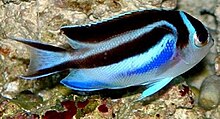
Marine angelfish are perciform fish of the family Pomacanthidae. They are found on shallow reefs in the tropical Atlantic, Indian, and mostly western Pacific Oceans. The family contains seven genera and about 86 species. They should not be confused with the freshwater angelfish, tropical cichlids of the Amazon Basin.

The lemonpeel angelfish, also known as the yellow angelfish, is a species of marine ray-finned fish, a marine angelfish belonging to the family Pomacanthidae. It is found in the Indo-Pacific region.
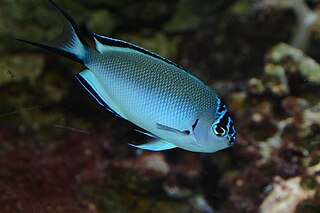
Genicanthus watanabei, the blackedged angelfish or Watanabe’s angelfish, is a species of marine ray-finned fish, a marine angelfish belonging to the family Pomacanthidae. It is found in the Pacific Ocean.
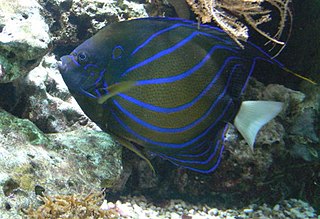
The bluering angelfish, also known as the annularis angelfish and the blue king angelfish, is a species of marine ray-finned fish, a marine angelfish belonging to the family Pomacanthidae. It is member of the genus Pomacanthus, composed of large marine angelfish.

The rock beauty, also known as corn sugar, coshubba, rock beasty, catalineta, and yellow nanny, is a species of marine ray-finned fish, a marine angelfish belonging to the family Pomacanthidae. It is found in the western Atlantic Ocean.

Centropyge eibli, the blacktail angelfish, red stripe angelfish, orangelined angelfish, or Eibl dwarf angel is a species of marine ray-finned fish, a marine angelfish belonging to the family Pomacanthidae. It is found near reefs in the Indo-Pacific.

Genicanthus semifasciatus, the Japanese swallow, is a species of marine ray-finned fish, a marine angelfish, belonging to the family Pomacanthidae. It is found in the Western Pacific.

Chaetodontoplus meridithii, the Queensland yellowtail angelfish, Meredith's angelfish or yellow-finned angelfish, yellowtail angelfish, is a species of marine ray-finned fish, a marine angelfish belonging to the family Pomacanthidae. It is found off eastern Australia.
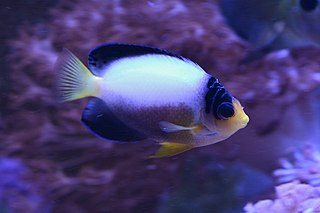
Centropyge multicolor, the multicolor angelfish or pearlback angelfish, is a species of marine ray-finned fish, a marine angelfish belonging to the family Pomacanthidae. It is from the Pacific Ocean that sometimes makes its way into the aquarium trade. It grows to a size of 9 cm in length.

Centropyge potteri, commonly known as the russet angelfish, Potter's angelfish or Potter's pygmy angelfish, is a species of marine ray-finned fish, a marine angelfish belonging to the family Pomacanthidae. It is found in the central Pacific Ocean.
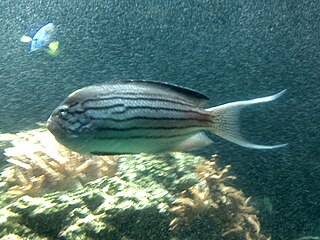
Genicanthus lamarck, the blackstriped angelfish or Lamarck's angelfish, is a species of marine ray-finned fish, a marine angelfish belonging to the family Pomacanthidae. It occurs in the Indo-West Pacific region.

Centropyge fisheri, the orange angelfish, whitetail angelfish, damsel angelfish, yellowtail angelfish, Hawaiian flame angelfish, Fisher’s angelfish, Fisher’s dwarf angelfish or Fisher’s pygmy angelfish, is a species of marine ray-finned fish, a marine angelfish belonging to the family Pomacanthidae. It is found in the Indo-Pacific region.
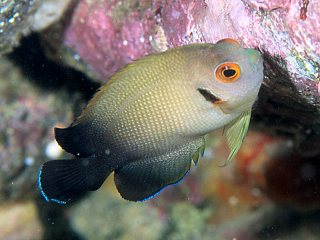
Centropyge vrolikii, known commonly as the pearlscale angelfish or half black angelfish, is a species of marine ray-finned fish, a marine angelfish belonging to the family Pomacanthidae. It is found in the Indo-Pacific.
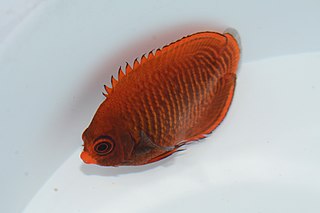
Golden angelfish, also known as golden pygmy angelfish or velvet dwarf angel, is a small marine ray-finned fish, a marine angelfish belonging to the family Pomacanthidae. It inhabits shallow reefs in the western Pacific Ocean.

Genicanthus personatus the masked angelfish, is a species of marine ray-finned fish, a marine angelfish belonging to the family Pomacanthidae. It is endemic to Hawaii.

Genicanthus melanospilos, the spotbreast angelfish, blackspot angelfish or swallowtail angelfish, the family Pomacanthidae. It occurs in the Indo-West Pacific region.

Genicanthus caudovittatus, the zebra angelfish, swallowtail angelfish, and lyretail angelfish, is a species of marine ray-finned fish, a marine angelfish belonging to the family Pomacanthidae. It is found in the Indian Ocean.
Genicanthus takeuchii, the spotted angelfish or Takeuchi’s angelfish, is a species of marine ray-finned fish, a marine angelfish belonging to the family Pomacanthidae. It is found in the northwestern Pacific Ocean

The halfbanded angelfish is a species of marine ray-finned fish, a marine angelfish belonging to the family Pomacanthidae. It is found in the southwestern Pacific Ocean.
The Pitcairn angelfish is a species of marine ray-finned fish, a marine angelfish belonging to the family Pomacanthidae. It is found in the southwestern Pacific Ocean.
